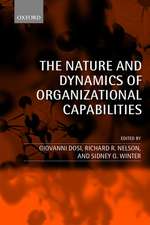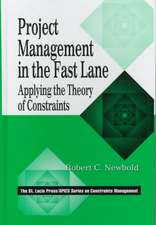Mathematical Models of Distribution Channels: International Series in Quantitative Marketing, cartea 17
Autor Charles A. Ingene, Mark E. Parryen Limba Engleză Hardback – 29 oct 2004
At the heart of their analysis is a single-manufacturer/multiple-retailer meta-model that embraces any degree of inter-retailer competition and any distribution of market shares. In Chapters 1 and 2 the authors provide an introduction to the current, analytical literature on distribution channels, and they present an intuitively appealing prologue to the Channel Myths that are developed rigorously in later Chapters. In Chapters 3, 4, and 10 they extend the literature by ascertaining the relationship between the manufacturer-optimal wholesale-price strategy and channel breadth. Specific analyses include multiple, non-competing retailers, multiple states-of-nature, and multiple, competing retailers. In Chapters 5-7 the authors determine the profitability of various wholesale-price strategies; this analysis culminates in Chapters 8 and 9 with the determination of the (very limited) conditions under which channel coordination can be optimal for the manufacturer. In Chapter 11 they prove that existing methods of measuring the effect of a change in the degree of inter-retailer substitutability are totally misleading. They then develop an original, theoretical basis for measuring the impact of a change in the degree of inter-retailer substitutability that yields insightful, intuitively appealing results. In Chapter 12 the authors set forth an agenda for future research based on a meta-model that embraces all existing models in the literature. They also issue an appeal for creation of a "Unifying Theory of Distribution Channels" that will enable researchers to work independently and yet to contribute toward the common goal of deepening the marketing science professions’ understanding of distribution channels.
| Toate formatele și edițiile | Preț | Express |
|---|---|---|
| Paperback (1) | 1230.84 lei 6-8 săpt. | |
| Springer Us – 8 dec 2010 | 1230.84 lei 6-8 săpt. | |
| Hardback (1) | 1237.61 lei 6-8 săpt. | |
| Springer Us – 29 oct 2004 | 1237.61 lei 6-8 săpt. |
Din seria International Series in Quantitative Marketing
- 18%
 Preț: 1138.98 lei
Preț: 1138.98 lei - 18%
 Preț: 785.55 lei
Preț: 785.55 lei - 24%
 Preț: 1051.80 lei
Preț: 1051.80 lei - 18%
 Preț: 956.69 lei
Preț: 956.69 lei - 18%
 Preț: 2115.56 lei
Preț: 2115.56 lei - 15%
 Preț: 643.48 lei
Preț: 643.48 lei - 18%
 Preț: 1220.12 lei
Preț: 1220.12 lei - 15%
 Preț: 639.41 lei
Preț: 639.41 lei - 18%
 Preț: 1390.59 lei
Preț: 1390.59 lei - 18%
 Preț: 945.47 lei
Preț: 945.47 lei - 18%
 Preț: 953.97 lei
Preț: 953.97 lei - 18%
 Preț: 1572.70 lei
Preț: 1572.70 lei - 15%
 Preț: 644.95 lei
Preț: 644.95 lei - 18%
 Preț: 1394.38 lei
Preț: 1394.38 lei - 18%
 Preț: 1815.63 lei
Preț: 1815.63 lei - 18%
 Preț: 2486.63 lei
Preț: 2486.63 lei
Preț: 1237.61 lei
Preț vechi: 1509.29 lei
-18% Nou
Puncte Express: 1856
Preț estimativ în valută:
236.82€ • 246.77$ • 196.08£
236.82€ • 246.77$ • 196.08£
Carte tipărită la comandă
Livrare economică 03-17 aprilie
Preluare comenzi: 021 569.72.76
Specificații
ISBN-13: 9781402071638
ISBN-10: 1402071639
Pagini: 604
Ilustrații: XXV, 568 p.
Dimensiuni: 155 x 235 x 38 mm
Greutate: 1.02 kg
Ediția:2004
Editura: Springer Us
Colecția Springer
Seria International Series in Quantitative Marketing
Locul publicării:New York, NY, United States
ISBN-10: 1402071639
Pagini: 604
Ilustrații: XXV, 568 p.
Dimensiuni: 155 x 235 x 38 mm
Greutate: 1.02 kg
Ediția:2004
Editura: Springer Us
Colecția Springer
Seria International Series in Quantitative Marketing
Locul publicării:New York, NY, United States
Public țintă
ResearchCuprins
A Commentary on Distribution-Channels Modeling.- The Bilateral-Monopoly Model and Channel Myths.- Multiple (Exclusive) Retailers.- Multiple (Exclusive) States-of-Nature.- Toward a Manufacturer-Optimal Per-Unit Fee: A Channel-Coordinating Quantity-Discount Schedule.- The Manufacturer-Optimal Two-Part Tariff.- The Channel-Coordinating Menu.- Coordination versus Maximization: Theoretical Analyses.- Coordination versus Maximization: Graphical Analyses.- The Competing-Retailers Model with Channel Breadth.- Modeling a Change in Competitive Substitutability.- Towards a Unifying Theory of Distribution Channels.
Textul de pe ultima copertă
Mathematical Models of Distribution Channels identifies eight "Channel Myths" that characterize almost all analytical research on distribution channels. The authors prove that models that incorporate one or more Channel Myths generate distorted conclusions; they also develop a methodology that will enable researchers to avoid falling under the influence of any Channel Myth.
At the heart of their analysis is a single-manufacturer/multiple-retailer meta-model that embraces any degree of inter-retailer competition and any distribution of market shares. In Chapters 1 and 2 the authors provide an introduction to the current, analytical literature on distribution channels, and they present an intuitively appealing prologue to the Channel Myths that are developed rigorously in later Chapters. In Chapters 3, 4, and 10 they extend the literature by ascertaining the relationship between the manufacturer-optimal wholesale-price strategy and channel breadth. Specific analyses include multiple, non-competing retailers, multiple states-of-nature, and multiple, competing retailers. In Chapters 5-7 the authors determine the profitability of various wholesale-price strategies; this analysis culminates in Chapters 8 and 9 with the determination of the (very limited) conditions under which channel coordination can be optimal for the manufacturer. In Chapter 11 they prove that existing methods of measuring the effect of a change in the degree of inter-retailer substitutability are totally misleading. They then develop an original, theoretical basis for measuring the impact of a change in the degree of inter-retailer substitutability that yields insightful, intuitively appealing results. In Chapter 12 the authors set forth an agenda for future research based on a meta-model that embraces all existing models in the literature. They also issue an appeal for creation of a "Unifying Theory of Distribution Channels" that will enable researchersto work independently and yet to contribute toward the common goal of deepening the marketing science professions’ understanding of distribution channels.
At the heart of their analysis is a single-manufacturer/multiple-retailer meta-model that embraces any degree of inter-retailer competition and any distribution of market shares. In Chapters 1 and 2 the authors provide an introduction to the current, analytical literature on distribution channels, and they present an intuitively appealing prologue to the Channel Myths that are developed rigorously in later Chapters. In Chapters 3, 4, and 10 they extend the literature by ascertaining the relationship between the manufacturer-optimal wholesale-price strategy and channel breadth. Specific analyses include multiple, non-competing retailers, multiple states-of-nature, and multiple, competing retailers. In Chapters 5-7 the authors determine the profitability of various wholesale-price strategies; this analysis culminates in Chapters 8 and 9 with the determination of the (very limited) conditions under which channel coordination can be optimal for the manufacturer. In Chapter 11 they prove that existing methods of measuring the effect of a change in the degree of inter-retailer substitutability are totally misleading. They then develop an original, theoretical basis for measuring the impact of a change in the degree of inter-retailer substitutability that yields insightful, intuitively appealing results. In Chapter 12 the authors set forth an agenda for future research based on a meta-model that embraces all existing models in the literature. They also issue an appeal for creation of a "Unifying Theory of Distribution Channels" that will enable researchersto work independently and yet to contribute toward the common goal of deepening the marketing science professions’ understanding of distribution channels.
Caracteristici
Provides a review of the mathematical modeling literature on distribution channels Evaluates that literature, offering a significant analytical extension to the existing work Addresses three central themes: channel coordination; vertical integration vs. decentralization; and the unique aspects of franchizing

















